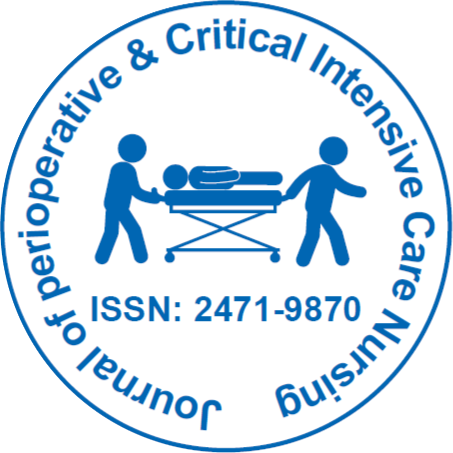
Journal of Perioperative & Critical Intensive Care Nursing
Open Access
ISSN: 2471-9870
+44-77-2385-9429

ISSN: 2471-9870
+44-77-2385-9429
Opinion - (2022)Volume 8, Issue 1
Many lung diseases, including cystic fibrosis, idiopathic pulmonary fibrosis, and Chronic Obstructive Pulmonary Disease (COPD), which affect millions of Americans, may be treated using stem cells, according to a team of scientists. The researchers showed that they could get human lung stem cells utilizing a reasonably non-invasive, doctor's office method. The harvested lung cells were then multiplied in the lab to provide an enough number of cells for human treatment. In a study conducted, the scientists demonstrated that they could successfully cure a model of IPF in rats and mice using the same sort of lung cells. IPF is a chronic, fatal condition marked by a steady decline in lung function. The first time that lung stem cells from minimally invasive biopsy samples have been produced is in this study. They anticipated that these lung stem cells' characteristics would make them potentially beneficial for treating a variety of lung fibrosis illnesses. The accumulation of fibrous, scar-like tissue, which is often brought on by persistent lung inflammation, is a symptom of many lung disorders. The lungs' ability to transport oxygen to the blood decreases when this fibrous tissue replaces lung tissue. Patients eventually run the danger of dying too soon from respiratory failure. Most people with Idiopathic Pulmonary Fibrosis (IPF), a condition associated to smoking, survive fewer than five years following diagnosis, right? The two Idiopathic Pulmonary Fibrosis (IPF) medication therapies that have been licensed by the FDA only address symptoms rather than the underlying disease process. The sole cure is lung transplantation, which has a high death rate and necessitates long-term immunosuppressive medication usage.
The alternative potential of employing stem cells to treat Idiopathic Pulmonary Fibrosis (IPF) and other lung fibrosis illnesses has been studied by scientists. To heal wounds, stem cells, which are developing cells, can multiply and mature into adult cells. Particularly appealing as prospective therapies for fibrosis illnesses are stem cell types that exhibit antiinflammatory and anti-fibrotic capabilities. Researchers have concentrated on a group of stem cells and support cells that can be successfully cultivated from biopsied lung tissues that are found in the lungs. Because of the characteristic sphere-like forms that these cells produce in culture, they are known as lung spheroid cells. When applied to a rat or mouse with lung fibrosis, lung spheroid cells demonstrated strong regenerative abilities, the researchers reported. These cells performed better than mesenchymal stem cells, which are another type of nonlung derived stem cell being researched for the treatment of fibrosis. In the first of the two new experiments, the group demonstrated that lung spheroid cells could be obtained from people with lung diseases via a trans-bronchial biopsy, which is a comparatively non-invasive approach. The airway tissue was sampled using a bronchoscope by taking minuscule, seed-sized fragments. Compared to a typical surgical biopsy of the lung tissue that requires chest penetration, this procedure poses far less danger to the patient.
From these small tissue samples, researchers also cultivated lung spheroid cells until they reached tens of millions and could be used therapeutically. When the cells were intravenously put into mice, they discovered that the majority of the cells accumulated in the animals' lungs. In the second trial, researchers initially gave rats a lung fibrosis disease. The illness resembled human IPF very much. The new developed spheroid cells were then administered to one group of rats by the scientists.
Scientists observed significantly less lung inflammation and fibrosis in the rats treated with lung spheroid cells as well as in this group of animals compared to another treated with a placebo. The procedure was also safe and successful whether the lung spheroid cells came from the recipients' own lungs or from the lungs of a different strain of rat. In other words, even if the donated stem cells were foreign, the recipient animals would still experience a negative immune response as transplanted tissue typically does.
Scientists anticipated that lung spheroid cells would first be taken from the patient when utilized therapeutically in people to reduce the danger of immunological rejection. However, in the end, surgeons could take cells from healthy volunteers as well as full lungs received via organ donation networks in order to produce enough cells for broad clinical usage.
The stem cells might potentially be used in patients or immunologically matched to recipients, similar to how transplanted organs are normally matched. IPF sufferers plan to request FDA clearance of the research later this year. In the long run, the researchers expect that patients with various lung fibrosis disorders, such as COPD, cystic fibrosis, and Fibro- Cavernous Pulmonary Tuberculosis, would benefit from their lung stem cell treatment.
Citation: Fukar A (2022) Stem Cell Therapy for Pulmonary Diseases. J Perioper Crit Intensive Care Nurs. 8:195.
Received: 07-Mar-2022, Manuscript No. JPCIC-22-20453; Editor assigned: 09-Mar-2022, Pre QC No. JPCIC-22-20453 (PQ); Reviewed: 24-Mar-2022, QC No. JPCIC-22-20453; Revised: 30-Mar-2022, Manuscript No. JPCIC-22-20453 (R); Published: 08-Apr-2022 , DOI: 10.35248/2471-9870.22.8.195
Copyright: © 2022 Fukar A. This is an open-access article distributed under the terms of the Creative Commons Attribution License, which permits unrestricted use, distribution, and reproduction in any medium, provided the original author and source are credited.